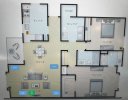rlal
Member
I was thinking to add a high performing sub to my current setup. My current setup is Salk Silk towers, Rythmik 12 inch sealed subwoofer made by Salk ( thicker cabinet wall and more bracing than Rythmik stock models) and two infinity book shelf speakers as rear surround speakers. I don't use a center speaker. I tried few center speakers and I never got a good match with my Silk towers.
My AVR is Arcam 850. I was pretty happy with performance except for bass.
Can you guys suggest me a good subwoofer which will improve the performance? I am planning to add one more sub with my present subwoofer. Please see my room layout.
In general I like tight or refined bass and not room shaking bass. I am more interested in music (mid bass slam) than movies. But I do enjoy good bass in movies.
Does ported sub can be good and be very fast like a sealed sub and with out port chuffing?
Basically looking for a fast subwoofer with good mid bass. Please let me know you suggestions.
Do I need to look for sealed sub or there are good ported subs which are musical? Please let me know.
Thanks
Rlal
My AVR is Arcam 850. I was pretty happy with performance except for bass.
Can you guys suggest me a good subwoofer which will improve the performance? I am planning to add one more sub with my present subwoofer. Please see my room layout.
In general I like tight or refined bass and not room shaking bass. I am more interested in music (mid bass slam) than movies. But I do enjoy good bass in movies.
Does ported sub can be good and be very fast like a sealed sub and with out port chuffing?
Basically looking for a fast subwoofer with good mid bass. Please let me know you suggestions.
Do I need to look for sealed sub or there are good ported subs which are musical? Please let me know.
Thanks
Rlal

